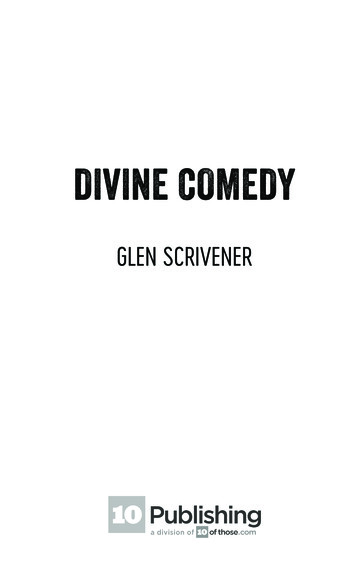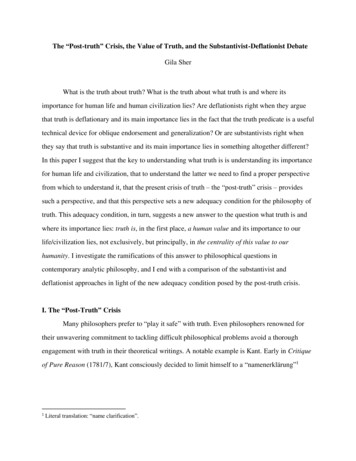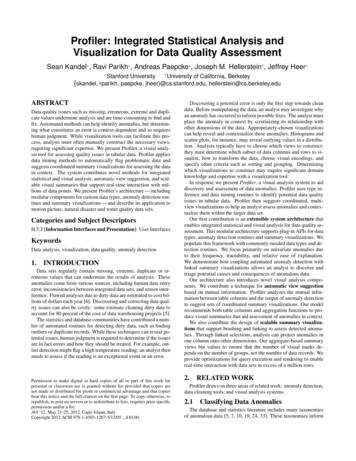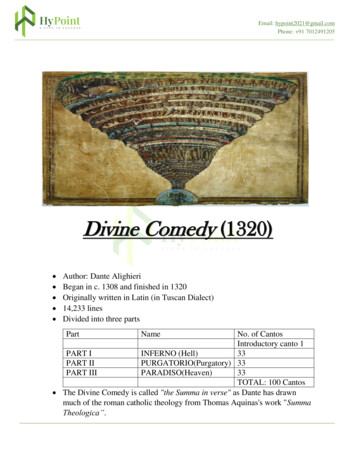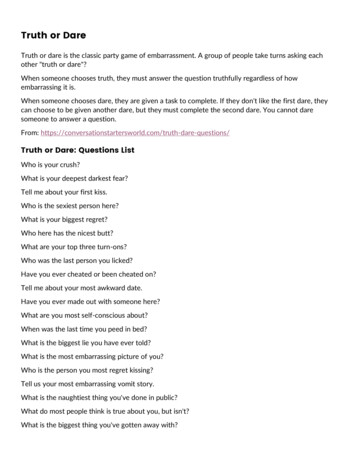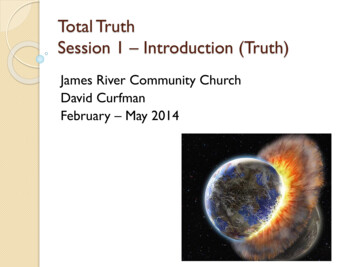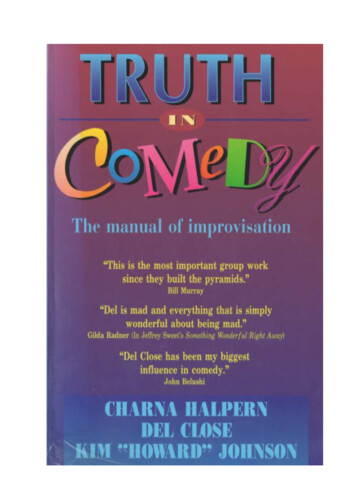
Transcription
Meriwether Publishing Ltd., PublisherP.O. Box 7710Colorado Springs, CO 80933Editor: Arthur L. ZapelTypesetting: Sharon E. GarlockCover design: Tom Myers Copyright MCMXCIV Meriwether Publishing Ltd.Printed in the United States of AmericaFirst EditionAll rights reserved. No part of this publication may be reproduced, stored in a retrieval system,or transmitted in any form or by any means, electronic, mechanical, photocopying, recording orotherwise, without permission of the publishers.Library of Congress Cataloging-in-Publication DataHalpern, Charna, 1952Truth in Comedy : the manual for improvisation / by Charna Halpern, Del Close, and Kim"Howard" Johnson. - 1st ed. p. cm. ISBN 1-56608-003-71. Improvisation (Acting) 2. Stand-up comedy. I. Close, Del, 1934-1999. II. Johnson, Kim,1955- . III. Title. PN2071.I5H26 1993 792\028-dc2093-43701CIP67801 02 03 04
DEDICATIONSCharna HalpernTo my loving parents, Jack and Iris Halpern.Without their constant calls to push me to continuewriting, this book might never have been finished.I also thank them for raising me in a home that wasalways filled with laughter. . . and to Rick Roman — wherever you are.Del CloseTo Severn Darden, Elaine May and Theodore J. Flicker.Kim "Howard" JohnsonTo Laurie Bradach, who improvises with me every day,and for the Baron's Barracudas, who blazed the trail.
ACKNOWLEDGMENTSSo many have been so wonderful.I'd like to send my thanks —To Bill Murray, Mike Myers, George Wendt, ChrisFarley, Andy Richter, and Andy Dick for their support —To Suzanne Plunkett, the best photographer in Chicago —To Thorn Bishop for his way with words —To David Shepherd, Paul Sills, and Bill Williamsfor their inspiration —To Betsy Nolan for being a perfectionist —To "The Family" and all the other ImprovOlympicteams, for helping us to learn from them —Special thanks to Kim Yale —
TABLE OF CONTENTSForeword by Mike Myers . 1Introduction I . 2Introduction II . 3CHAPTER ONEWhat Is Improv, Anyway? 7CHAPTER TWOBut Seriously, Folks 13CHAPTER THREESupport and Trust . 22CHAPTER FOURAgreement. 27CHAPTER FIVEInitiations and Game Moves 35CHAPTER SIXMoment to Moment to Moment 44CHAPTER SEVENBuilding a Scene .49CHAPTER EIGHTOne Mind, Many Bodies . 55CHAPTER NINEEnvironmentally Aware 62CHAPTER TENResponsibilities of a Harold Player . 72CHAPTER ELEVENHow to Do a Harold 81CHAPTER TWELVEHarold As a Team Sport . 90About the Authors . 91
ForewardThe end is in the beginning.The Harold is an improv game that was introduced to me in Toronto, Canada, by DelClose and Charna Halpern. The first time I played the Harold it blew me away and it continuesto blow me away to this day. The Harold isn't just a game — it's a way of looking at life. Thebasic principle of the Harold is adaptation, and being adaptive is the most crucial lesson I'velearned. It provides you with a glossary of terms for the creative process and identifiesrecurring patterns in your imagination. It's the Zen approach to comedy. Most importantly, theHarold is a lot of fun.Del Close, Charna Halpern and the Harold have been a major influence in my life. WhenI'm blocked I return to the methods of the Harold.After all, the end is in the beginning.— Mike Myers1
INTRODUCTION II began producing the ImprovOlympic in 1981, after I met David Shepherd, one of thecreators of Second City and the founder of the ImprovOlympic. David's inspiration came fromancient Greece, where the Olympian Games were a festival of sports, literature, music, anddance held every four years to honor Zeus, king of the gods. The Greeks saw the relationshipbetween sports and the arts as innate. Both involved the exploration and extension of man'spossibilities, rather than the perfection of his limitations (as is the case when art is reduced toarts and crafts and sports are reduced to stats and standings).During our first year together, David and I developed separate visions for theImprovOlympic, and we had a parting of the ways. I continued on to create an entertainingtheatrical sport. In 1983,1 found myself in need of inspiration. While the ImprovOlympic wasa commercial success, it was beginning to look like a replica of Second City, which I wanted toavoid. Second City was already doing Second City quite well. I knew there was more toimprovisation than three-minute scenes, but I wasn't sure what. I then met Del Close, whobecame a constant source of inspiration.Del had a game to show me and my class, which he called "the Harold." This was not,however, the Harold we know and love today. Its nascent form was a little too large andchaotic for the stage. The trick would be preserving the chaos on stage while at the same timemaking it comprehensible. I showed Del one of my games called the Time Dash, a three-partscene where situations are carried out through spans of time.We discovered that inserting the Time Dash along with my other short improvisationalgames into the Harold's long structure gave it a perfect form. Del and I felt like the people Inthe candy commercial who collide together. One says, "You've got chocolate in my peanutbutter!" The other replies, "You've got peanut butter on my chocolate!" Hence, the birth of theHarold as it is known today.Del and I have developed the newest advancement in improvisation. The Harold is nowbeing done on college campuses all across the United States, as well as on the stages of theImprovOlympic and Second City. In addition, the Improv- Olympic has become widely knownas the best training ground for improvisers anywhere, a tradition Del started long ago with histraining of John Belushi, Bill Murray, John Candy, Gilda Radner, and many others.Our directors have been training top performance troupes to perform Harolds in ourshow, which has been referred to as the most daring game in town. Most importantly, we arecontinuing Del's tradition of fostering the finest talents of the future.Those who have studied with us over the years have agreed that Del and I have discoveredthe "Truth" about successful improvisation. Because of our successful curriculum, I decided itwas time to put it all down in a book so that others could be trained properly. When I suggestedthe idea to Del, he replied that it would be as much work as writing up a religion. He was lessthan excited about such a task. I can recall his words to this day: "You can do it, if you want."As usual, Del was right. It was quite an undertaking. But after the book began takingshape, Del was there providing his usual expertise and divine inspiration.2
I invite the reader to "come in" and discover our secrets. However, while the details of ourinstruction are here in this book, there is nothing as important as a good and clear director tosolve the particular problems that can't always be foreseen in a book of this sort. TheImprovOlympic will provide those directors wherever they are needed.In the past, people had labeled Del a "mad genius" because of his theories ofimprovisation. By now they've discovered he wasn't mad — he was right. Del has said that heis grateful that I have chosen to do his work his way. There is no mystery as to why I wouldchoose to do this. His methods are correct, and his philosophies have provided us with theTRUTH IN COMEDY.— Charna HalpernINTRODUCTION IIThe life of Del Close is virtually a history of American improvisation.Del started his comedy career with Mike Nichols and Elaine May in the Compass Playersin St. Louis during the 1950s.* Moving on to Second City and San Francisco's legendaryCommittee, Del returned to Second City in time to direct successes like John Belushi and BillMurray. In fact, there are very few successful improvisers who have not worked with or beeninfluenced by Del's work.Although Del has worked on stage and screen throughout the years, he has been teachingor directing improv almost continuously since the 1950s and continues into the '90s.Ed Asner, who began improvising in the '50s in the Playwright's Theatre Club at theUniversity of Chicago, calls Del "a mad genius." Chris Farley, who joined Saturday Night Liveafter working with Del in the ImprovOlympic, says, "Del is the greatest teacher I've everknown. I would not be where I am today were it not for Del, that's for sure. I owe everything toDel. He brought me to Second City, and he taught me everything I needed to know."Del's partner, Charna Halpern, was working with Compass Players founder DavidShepherd in the early '80s in Chicago. When they went their separate ways, Charna joinedforces with Del, and they began operating the ImprovOlympic. Their classes have turned outhundreds and hundreds of accomplished performers.My own background in the early '80s included a fervent interest in comedy writing andperforming; I had long been a fan of Saturday Night Live (where most of the performers hadbeen directly influenced by Del) and Monty Python, becoming friends with the latter (workingwith them on Life of Brian and subsequently writing three books on the group).*Actually, it could be argued that he began as a teenager, when he toured as a fire-eater with Dr. Dracula and his Tomb of Terrors;his duties included throwing handfuls of cooked spaghetti on the audience during a blackout when Dr. Dracula called for a plague ofworms to descend upon them.3
I moved to Chicago and started studying at Second City. In those naive early days, I stillthought improv and comedy were interchangeable terms. Del had by then departed SecondCity and started working with Charna and the ImprovOlympic, and word around Second Cityhad it that Del was the person with whom to study improv. I immediately signed up for classes.During the first year I spent studying with Del and Charna, Del would make occasionalreferences to something called "the Harold." At the time, though, he was too busy trying toteach us the principles of simple scenes and games to elaborate.Eventually, the details came. "Harold" was the name of a form of improv that Del haddeveloped in the late 1960s while working with San Francisco's legendary improv troupe TheCommittee. The group was searching for some way to unite all their games, scenes, andtechniques into one format; they developed a way to intertwine scenes, games, monologs,songs, and all manner of performance techniques.They came up with one of the most sophisticated, rewarding forms of pure improv everdeveloped.And then they had to name it.A few years earlier, in A Hard Day's Night, a reporter asks George Harrison what hecalled his haircut. "Arthur," he responds.So when Del asked his group what this exciting new form of improv should be called, oneof his actors, Bill Mathieu, answered "Harold."It has always been a minor annoyance for Del that his life's work has been saddled withsuch an inane, silly title. But the name stuck.Saturday Night Live's Tim Kazurinski, who learned to play the Harold from Del atSecond City, says he didn't really understand the name for many years."For years, I thought it was 'Herald.' I thought it was, in British terms, heraldic, withtrumpeters that came out and heralded the cherubim and the seraphim! I thought it was apronouncement about the topic selected by the audience," says Kazurinski. "Years later, Ifound out that it was 'Harold,' some guy's name. I once got into a big fight with someone aboutit. I was going 'Oh, no, no, it's a much more important title than that. Boy, are you stupid! Youthought it was Harold?! And I was wrong — it's a dumb name for something really ratherwonderful."As I continued my improv studies we did some experimental performances with a newform of improv called Slow Comedy. It was interesting and exciting, but it wasn't Harold.It wasn't until the following spring that Del and Charna had trained our groups thoroughlyenough to revive the Harold before Chicago audiences. We ended up pitting teams againsteach other, letting the audiences vote for the winner. Harold became a unique sporting eventand a theatrical competition.The Harold was off and running, and it hasn't slowed down yet.***When I first heard that Charna wanted to do a book on the Harold, I was skeptical. Notbecause she doesn't have the credentials, but because I felt improv — and the Harold in4
particular — is a live experience, a living, breathing creature that can't fully be captured onpaper.But then I started thinking about all the potential improvisers scattered across the countrythat don't have easy access to Charna and Del. There are all sorts of eager comedy groups thatwill never advance beyond lame TV-show parodies without some sort of instruction. This isthe guidebook they've been waiting for, the mother of all improv books, with Charna and Deltelling what they know about Harold — which should be enough to keep most performers busyfor the next few decades.Harold is useful for more than performing, though. Harold training is beneficial for allsorts of people, from salespeople to public speakers. From personal experience, I know howimprov is useful to writers: improvisers are trained to start their scenes in the middle andalways eliminate clutter, principles that all good writers should implement.One of the biggest misconceptions about improvisation is that only trained actors andcomics can be successful. Actually, anyone can improvise. We all do it every day — none of usgoes through our day to day life with a script to tell us what to do.The simple, basic rules laid down in this book will result in much funnier, intelligent, andmore interesting scenes. Deliberately trying to be funny or witty is a considerable drawback,and often leads to disaster. Honest responses are simpler and more effective. By the sametoken, making patterns and connections is much more important than making jokes.This book should be looked on as a starting point; these are the blueprints that lay thegroundwork. Real improv involves constant experimentation and exploration. Anyone whouses this book correctly will eventually make all sorts of original discoveries on his own —and that's part of the magic of the Harold.Whether you're an experienced improviser or a curious neophyte, you're in for a treat. TheHarold is the most exciting, innovative, funniest advanced form of improv yet devised — evenif Del isn't fond of the name.— Kim "Howard Johnson5
If we want to see where we went wrongWe needn’t look too farFor where we'll be and where we've beenIs always where we are.And everything that comes your wayIs something you once gave9Somebody feels the waterEvery time you make a wave.— Thom Bishop6
CHAPTER ONEWhat Is Improv, Anyway?The word "improv" has been thrown around with reckless abandon over the years.There is a national chain of comedy clubs called "The Improv," along with a TV seriesentitled A Night at the Improv.Second City, where improvisation was refined and turned into a commercial success,continues to present comedy revues at its Chicago and Toronto locations, with touringcompanies traveling extensively.And there are plenty of other performers doing improv comedy in clubs and theatersacross the country.The Improv clubs feature stand-up comics performing material that has been written,rehearsed, and polished in front of hundreds of audiences. They may throw in an authenticad-lib or two during a performance, but very few of their acts are based on improvisation.Second City today uses improvisation to develop material for their comedy revues. Manyof their sketches are written, and then revised and perfected by improvising in front of anaudience. Even the improv sets, performed nightly after the regular revues, rely heavily onmaterial that is being developed for upcoming shows.Then what exactly is improv?Real improvisation is more than just a garnish, thrown like parsley onto a previouslyprepared stand-up comedy routine. Nor is it just a tool used to manufacture prepared scenes.True improvisation is getting on-stage and performing without any preparation orplanning.Sounds easy, doesn't it? Even audience suggestions aren't necessary. Strictly speaking,improvisation is making it up as you go along.This definition makes all of us expert improvisers. We all go through life every daywithout a script, responding to our environment, making it up as we go along. Improvisingon-stage is obviously a little different — the performers are trying to create while entertainingan audience.Sure, improvisation was created to develop comedy for its own sake. Every writer orperformer improvises as he or she creates, even if the only available audience is his typewriteror television set. Improvisation can be more than just a creative tool, though — it can be avastly satisfying form of entertainment.People often ask, "What do you use improvisation for? Is it to help an actor understand arole? To develop comedy material? As therapy?"Improvisation is not some poor relation to "legitimate" theater, such as ballet or opera. Itis an art form that stands on its own, with its own discipline and aesthetics. The roots of improvcan be seen in the venerable and influential 16th-century theatrical form known as commediadell’arte.7
Improvisation can be seen as the 20th-century descendant of the commedia, with Haroldas its most ebullient incarnation. Thus far, it hasn't gotten the respect it deserves from the"legitimate" theater community, but when it's properly considered a public art form, thequestion "What is it used for?" no longer applies.This book is geared largely toward improvisation, and its role in discovering the truthsabout comedy. As the purists will be quick to point out, improvisation is not necessarily funny(even when it's intentional, as plenty of actors who have "died" on-stage will attest to). Thefirst improvisations performed by the Compass Players and other forerunners to Second Citywere not always intended to be humorous.In recent years, though, improv has become synonymous with comedy. This slightlyskewed image has come about through such aforementioned establishments as Second City,the Improv, and many others. Since this volume is geared toward truth in comedy, however,we will politely tip our hats in acknowledgment of the more serious uses of improvisation, andsaunter off in the direction of chuckles, chortles, and guffaws.HOW TO BE FUNNYFirst of all, no one can read a book and become funny.So, if you've just bought this book in the hopes of becoming popular, earning a reputationas a silver-tongued raconteur, or scoring points with the opposite sex, you might as well returnthis to the bookstore and exchange it for a copy of 1001 Jokes, Jests, and Jibes.That said, it is possible to learn techniques that teach you how to become a funnyperformer, and they don't involve memorizing pages of stale jokes. Everyone who has everperformed comedy has their own definite ideas about how to be funny. But the simplest andmost basic concept may also be the most effective.The truth is funny.Honest discovery, observation, and reaction is better than contrived invention.After all, we're funniest when we're just being ourselves. Sitting around relaxing withfriends usually inspires far more laughter than a TV sitcom or someone trying to tell jokes.When was the last time you laughed out loud? Odds are that most of your recent belly laughswere the results of talking with friends.When we're relaxing, we don't have to entertain each other with jokes. And when we'resimply opening ourselves up to each other and being honest, we're usually funniest- We’ve allsat down with two or three friends and described an incident or discussed something thathappened in our lives. This is precisely what a stand-up comic does, although a stand-up'saudience is usually (though not always) larger than two or three people.The freshest, most interesting comedy is not based on mother-in-law jokes or JackNicholson impressions, but on exposing our own personalities. One of the most disquietingmoments for a novice performer is when he (or she) gets a laugh that is completely unexpected.Improvisers often like to feel "in control" of scenes; such laughter tends to prove just theopposite is occurring.8
Giving up control may be disastrous for a stand-up comic, but an improviser has to put histrust into the hands of the ensemble, and be prepared for those inevitable, frightening mysterylaughs — no matter how embarrassing they may be. As Steve Martin says, "Comedy is notpretty." Just let it happen.When an improviser lets go and trusts his fellow performers, it's a wonderful, liberatingexperience that stems from group support.A truly funny scene is not the result of someone trying to steal laughs at the expense of hispartner, but of generosity — of trying to make the other person (and his ideas) look as good aspossible.Real humor does not come from sacrificing the reality of a moment in order to crack acheap joke, but in finding the joke in the reality of the moment.Simply put, in comedy, honesty is the best policy.HAPPILY EVER AFTERFollowing the rules of a game and remaining true to a premise generally results in muchbigger laughs than inventing witty statements.When Del was directing a Second City company in Toronto that included Dan Ackroyd,Dave Thomas, and Gilda Radner, they began playing an improv game called "HappilyEver After." The premise is a simple one: an improv group presents a popular fairy tale,beginning with the moment the tale traditionally ends ("They lived happily ever after.").This company picked "Hansel and Gretel," beginning just after the children push theWicked Witch into the oven. A simple premise to go on. The performers were wise enough touse the characters and situations that were established in the original fairy tale, rather thaninvent new ones in hopes of laughs. They were savvy enough to trust that there was enoughmaterial in the real "Hansel and Gretel" to make their follow- up highly entertaining — andthey were right.As the narrator, Dan Ackroyd picked up on the rather grisly ending of the story andmerely extrapolated from the situation. The story presented by the company began with people— including a number of woodcutters — disappearing from the Black Forest, never to beheard from again. A search party eventually discovered two cannibal children — Hansel andGretel (Dave Thomas and Gilda Radner) — in the woods. As explained by Ackroyd, after thechildren had pushed the Witch in the oven, they ate her. Subsequently, they acquired a taste forhuman flesh, and the two young cannibals began preying on victims in the woods. The childrenwere then put on trial in Germany during World War II, and the company staged a parody ofthe Nuremberg War Trials.Even though the scene took some very peculiar twists, it was all rooted in the premise putforth in the original fairy tale, instead of inventing situations and lines for cheap jokes.Ackroyd simply hypothesized — from the original ending of pushing the Witch in the oven —that the children then decided to taste her. Everything else in the scene stems directly fromthere!9
HAROLD WHO?If honesty is the best road to comedic improvisation, the best vehicle to get us there isHarold.Simply put, it is the ultimate in improvisation.The Harold is like the space shuttle, incorporating all of the developments and discoveriesthat have gone before it into one new, superior design.All of the discoveries made about creating scenes, all of the games that have beendeveloped, all of the principles regarding truth in comedy, can become part of the cohesive,unified whole that is the Harold.Skilled Harold players take all of these disparate ingredients and build something muchgreater than the sum of its parts.Uninitiated audiences watching a Harold for the first time seldom know what to expect.What they see is a full company of improvisers on stage who do nothing but improvise fromstart to finish, something quite rare in the world of comedy.The first rule in Harold is that there are no rules. Still, a basic Harold usually takes on ageneral structure described as follows.Harold begins with a group of players — six or seven is usually ideal (although successfulHarolds have been performed with fewer than five persons and as many as 10 or 12). When thegroup steps onto the stage, they may want to check out the performing space, looking foraspects of it that can be incorporated into the Harold. The team solicits a suggestion for atheme from the audience, and begins a warm-up game to share their ideas and attitudes aboutthe theme. The warm- up can be very physical, or it can be as simple as a game of wordassociation.Eventually, a couple of players usually start a scene. Normally, it's unrelated to the theme,although it can be inspired by elements of the warm-up game. Once the scene is established, itwill be cut off by a second scene, one which has as little to do with the first scene as it has to dowith the theme. After a third scene is similarly presented, the ensemble will then participate inwhat is generally referred to as a "game” although the event may bear little resemblance to theaudience's notion of a game.The initial three scenes usually return again. This time, they may have some bearing onthe theme. Or, maybe not. After a second group game, the scenes return for one last time, oftentying into each other and the theme, culminating in a finale that incorporates the theme and asmany elements from the scenes and games as possible.It may sound complicated to the uninitiated, but its structure is similar to a three-act play.When it's performed by a group of trained improvisers, the results can be spectacular.To put it another way, a Harold is a lot like sex. When it is good, it's very good. When it isbad, it's still pretty good.10
Del tells about seeing Jim Belushi run off stage after a particularly inspiredimprovisation, shouting, "This is better than sex!" In fact, anyone who has participated in areally good Harold knows the indescribable rush that accompanies it.Earlier Harolds were not as refined as they became during the ImprovOlympia, thoughthey were still very useful, says Tim Kazurinski, who studied with Del at Second City in thelate 1970s."When we did the Harold back then, we'd take an audience suggestion and line up againstthe back wall. Alternately, we would begin coming forward in groups of two, starting scenesthat really weren't going anywhere yet. Another couple Would cut you off or you would fade tothe back wall when you were tiring. You would keep this up for 15 or 20 minutes, until 11these little vignettes began to tie up or interweave," explains Kazurinski."What seemed like a dopey little scenario early in the piece now started to take shape, asother people started joining that scene, and it became a recurring scene or 'runner.' When wasreally humming, they would all mesh, and make a statement that was more of a tableau.Everything that you had up to that point was synthesized in that final scene or conglomerationof scenes. What had washed over the audience was a really fascinating 20- or 30-scene barrageabout this topic, more than you ever knew — or possibly wanted to know — about the selectedtopic."When it works, it's an amazing thing. And when it doesn't, the audience thinks you'reinsane," he laughs. "But something good always comes from it. Even if we missed the mark,there were usually enough interesting events happening to make people think about that topic."Saturday Night Live's Chris Farley, an ImprovOlympic alumnus, loves theunpredictability of the Harold."Anything can happen," says Farley. "It is something that is created slowly, out of themoment. It's spontaneous and magic."Another of Del's illustrious alumni is George Wendt of Cheers fame, who Del directed atSecond City. Wendt agrees the Harold is terrific, both for performance and for developing newcomedic material."We never did quite enough Harolds at Second City," remarks Wendt. "I always felt thatwhen done correctly, the Harold is the most magical, wonderful improvisational experienceyou can have, both for the audience and for the company. Very satisfying. But even if it wasn'tentirely clicking as a performance piece, it was invaluable. I thought it was the best way tocreate material."To me, taking a theme and working on your feet — without discussions, qualifications,setups, blackouts, and the like — is a much purer and easier way to find kernels of scenes thatcould be expanded and written," explains Wendt."The exact opposite would be the Second City approach, which is to take a bunch ofsuggestions and write them on a piece of paper, stand backstage in the Green Room, and stareat a blackboard with a bunch of suggestions on it — basically stare at words. I got nothing fromthat. Second City was a constant struggle for me in terms of it being fun to improvise, and interms of creating material."In contrast, he describes the Harold as a completely emancipating experience.11
"Harold is like jumping out of an airplane! It's like being thrown into the water — you'vegot to sink or swim," exclaims Wendt. "The very intensity of the pressure to create isliberating.According to Wendt, a good Harold is not only fun for the performers and their audience,it's also a great way to come up with ideas for future material."It's a wonderful thing in and of itself, and as a means to an end — creating material — it'sequally wonderful. If you do a half-hour Harold, and you don't come out of that thing with atleast a blackout, you've had a pretty lame night," says Wendt. "Conversely, if you do ahalf-hour Harold and you come out of it with a killer blackout, it's been well worth it!"Like so many successful performers, George Wendt values his Harold training. These
Truth in Comedy : the manual for improvisation / by Charna Halpern, Del Close, and Kim "Howard" Johnson. - 1st ed. p. cm. ISBN 1-56608-003-7 1. Improvisation (Acting) 2. . The life of Del Close is virtually a history of American improvisation. Del started his comedy career with Mike Nichols and Elaine May in the Compass Players

